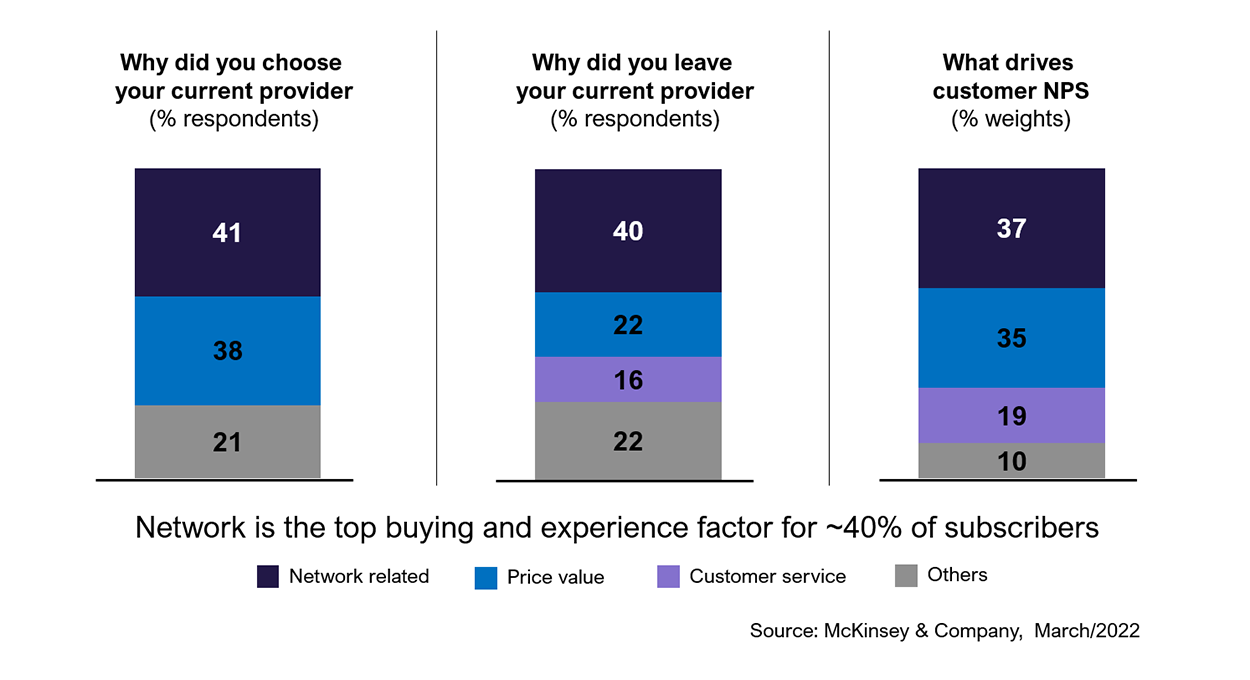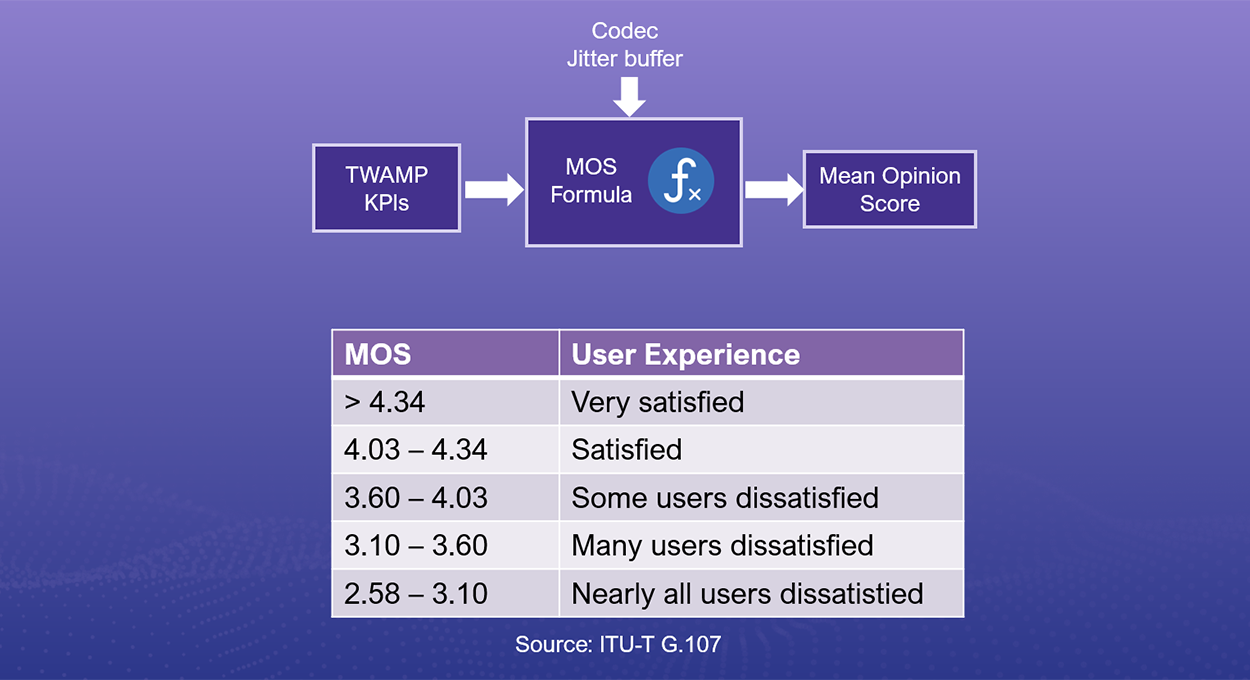User Experience Monitoring in Modern Data Networks

Providing an excellent network experience to the users is key for operators today. Some studies on this topic show that the network is the top buying factor and the biggest contributor to churn. Optimizing the network and targeting network investments to parts of the network where they matter the most is the foundation for success as we have pointed out in our earlier blogs on TWAMP monitoring.

Figure 1 Network Experience is Key to Obtain New Customers and Reduce Customer Churn
But even if the network is working perfectly, the user experience may still suffer from other factors that are not directly related to the transport network. For instance, web browsing is depending heavily on how well the Domain Name Service (DNS) works. When the user enters a new web link, DNS lookups tell where on the Internet the web server is and if the DNS lookup is slow or even fails, it will take a long time before the browser renders the new page. From the user’s perspective, it still looks like the network is performing poorly although the source of the issue is somewhere else.
It is therefore very important to not only monitor network performance but also to monitor the user experience of the network so that you have full visibility into the performance from the user’s perspective and can react to any degradations.
In this blog, we look at three important use cases for business: voice, web browsing, and video conferencing. In a subsequent blog, we will further look at some additional consumer-related use cases.
Voice Services
Out of the Key Performance Indicators (KPIs) for voice services, the one that affects the service quality the most is jitter, which is the variation of packet delay. Voice calls expect a steady stream of packets containing voice information. End devices will buffer a few packets, typically perhaps 30-50ms worth of voice data. This means that if there is a variation in packet arrival times (jitter) greater than 30 milliseconds, the service quality is degraded significantly resulting in clipped words and voice drop-out. Loss of packets also degrades the performance significantly resulting in choppy or distorted audio.
Ensuring that your jitter stays below 30 milliseconds and that you have no packet loss using, for instance, the TWAMP protocol for network quality measurements is already a very good approach to ensure good voice quality on your network. Furthermore, the ITU-T telecom standardization organization has defined formulas for calculating the Mean Opinion Score (MOS) for voice on a scale from one to five based on delay, jitter, packet loss, and other service quality-related parameters. Keeping the MOS value above 4.0 ensures that the quality of the voice calls is good and is a very easy and understandable way to track the performance of this service.

Figure 2 Using MOS to Ensure a Consistent Voice Service in Terms of Quality
Web Browsing
Web browsing imposes totally different requirements for network connectivity compared to voice services. For browsing, jitter itself has little meaning, and what the user will appreciate is to get the total web page downloaded as quickly as possible. The main impacting quality parameters for this type of traffic are the Domain Name Service (DNS) performance and throughput, which directly affects the page download time.
As discussed earlier in this blog, the DNS lookup plays a fundamental role in translating human-readable domain names (e.g., example.com) into machine-readable IP addresses (e.g., 192.0.2.1) required for locating and accessing websites on the internet. By monitoring DNS resolution times, you can assess the efficiency of DNS servers and identify potential issues. Recommended resolution times for the DNS service are typically less than 120 milliseconds. You can improve the overall responsiveness by, for instance, optimizing DNS configuration, implementing DNS caching, and utilizing fast and reliable DNS providers.
Page download time is another critical component of the user experience for web browsing, which directly influences how quickly users can access and interact with content. Slow-loading pages frustrate users regardless of whether the network is the reason for the delays or something else. The operator may improve page download times by ensuring that the network is reliable (no packet loss) and fast and cache web content close to the consumers by using Content Delivery Networks (CDNs). Typically, a page download time of less than three seconds is sufficient to provide a good browsing experience.
Video Conferencing
Video-conferencing is one of the most challenging services to provide as it involves both real-time video and voice as well as advanced session signaling. Packet loss has a significant impact on the user experience similar to voice. Packet loss impacts both video, voice, and signaling, with jittery video, audio glitches, and dropped connections as a consequence. High latency can lead to delays in audio and video transmission, causing communication lags and disruptions. And jitter can cause uneven video and voice playback.
Hence, for video conferencing, the operator must monitor packet loss, jitter, and delay. Additionally, monitoring the voice MOS can provide further insights into how users are experiencing the service as described earlier.
Establishing peering and interconnection agreements with major video conferencing providers can improve the delivery of video conferencing traffic as it minimizes the number of network hops. Typical recommendations for video conferencing from the user premises to the video conference provider edge is to keep jitter below 15 milliseconds, one-way delay below 30 milliseconds, and packet loss below 0.1%.
Conclusions
Ensuring a good user experience is vital for the operator to retain existing customers and to attract new ones. We described in this blog how operators should monitor three of the most important use cases for business: voice, web browsing, and video conferencing. In an upcoming blog, we will further look at relevant use cases for consumers.
To learn more about how to build modern monitoring capabilities using the TWAMP protocol, you can read the mobile transport customer case study from our website or download our mobile transport performance monitoring solution brief.
About Creanord
Creanord offers technology solutions for network performance measurements and quality assurance. Driven to turn data into outperforming networks, Creanord helps mobile operators, managed service, and wholesale providers as well as critical communications providers to design, offer, and deliver services with confidence.
With PULSure, service providers can track network performance and user experience in order to meet the most demanding service needs of their customers.
Since 2000 Creanord has served customers who offer the most demanding networks and applications making societies smarter, businesses more competitive and our lives safer.
Creanord is headquartered in Helsinki, Finland with a global operations and partner network.